Estate Crops More Attractive than Community Forests in West Kalimantan, Indonesia
Abstract
:1. Landscapes in the Heart of Borneo
2. Conceptual Framework
2.1. Community Management in Indonesia’s Landscapes
If we truly want to address issues of climate change, poverty, forest and biodiversity loss effectively, the global community will have to devote far greater efforts than has occurred to date to accessing the views, preferences, and goals of marginalized peoples, understanding local social systems, and incorporating such information into policies, laws, and regulations.[2]
2.2. Flawed Assumptions
3. Methods
4. Results
4.1. Sintang Case: Development Opportunities Arise
“I have connections in the city and think that the opportunity to live well out here depends on my willingness to be opportunistic, investing in expansion and experimentation so that risk is counterbalanced by delivering products to market, and my freedom to choose that market.”(panel data respondent No. 1)
“There is not enough land left for us to do what we use to do, some of that is because of our population expansion, some of that is because companies now own large plantations.”(FGD respondent)
4.2. A Forest at Stake
“The road has existed for a long time, without it we would not be here doing what we do now. But we want more, we want to be able to reach markets, we want paved roads so that we are safe in cases of emergencies and for easier day to day lifestyle.”(panel data respondent No. 2)
“The economic opportunities provided by road access originally stimulated by the oil palm industry has made life better. There are some social costs but we all now have a desire for modern amenities and want to live prosperously.”(panel data respondent No. 3)
“We would ideally choose office jobs but invest in land. We want some forests to remain, but want to profit from our lands and while living in the city. In 100 years there will be no people living here anymore. They will all be either working on plantations or in jobs in the city.”(panel data respondent No. 4)
5. Conclusions
Local people almost always express a strong desire for development and lament their few opportunities….[1]
Acknowledgments
Author Contributions
Conflicts of Interest
References
- Levang, P.; Riva, W.F.; Orth, M.G. Oil palm plantations and conflict in Indonesia: Evidence from West Kalimantan. In The Oil Palm Complex: Smallholders, Agribusiness and the State in Indonesia and Malaysia; NUS Press: Singapore, 2016; pp. 283–300. [Google Scholar]
- Colfer, C.J.P. Marginalized forest peoples’ perceptions of the legitimacy of governance: An exploration. World Dev. 2011, 39, 2147–2164. [Google Scholar] [CrossRef]
- Meijaard, E.; Abram, N.K.; Wells, J.A.; Pellier, A.-S.; Ancrenaz, M.; Gaveau, D.L.; Runting, R.K.; Mengersen, K. People’s perceptions about the importance of forests on Borneo. PLoS ONE 2013, 8, e73008. [Google Scholar] [CrossRef] [PubMed]
- Peluso, N.L. The political ecology of extraction and extractive reserves in East Kalimantan, Indonesia. Dev. Change 1992, 23, 49–74. [Google Scholar] [CrossRef]
- Bullinger, C.; Haug, M. In and out of the forest: Decentralisation and recentralisation of forest governance in East Kalimantan, Indonesia. Austrian J. South-East Asian Stud. 2012, 5, 243–262. [Google Scholar]
- Gallemore, C.T.; Rut Dini Prasti, H.; Moeliono, M. Discursive barriers and cross-scale forest governance in Central Kalimantan, Indonesia. Ecol. Soc. 2014. [Google Scholar] [CrossRef]
- Myers, R.; Sanders, A.J.; Larson, A.M.; Ravikumar, A. Analyzing Multilevel Governance in Indonesia: Lessons for REDD+ from the Study of Landuse Change in Central and West Kalimantan; CIFOR (Center for International Forestry Research): Bogor, Indonesia, 2016. [Google Scholar]
- Hitchner, S.L. Heart of Borneo as a ‘Jalan Tikus’: Exploring the links between indigenous rights, extractive and exploitative industries, and conservation at the world conservation congress 2008. Conserv. Soc. 2010, 8, 320–330. [Google Scholar] [CrossRef]
- Sayer, J.; Cassman, K.G. Agricultural innovation to protect the environment. Proc. Natl. Acad. Sci. USA 2013, 110, 8345–8348. [Google Scholar] [CrossRef] [PubMed]
- Potter, L. Managing Oil Palm Landscapes: A Seven-Country Seurvey of the Modern Palm Oil Industry in Southeast Asia, Latin America and West Africa; CIFOR (Center for International Forestry Research): Bogor, Indonesia, 2015. [Google Scholar]
- Carlson, K.M.; Curran, L.M.; Asner, G.P.; Pittman, A.M.; Trigg, S.N.; Adeney, J.M. Carbon emissions from forest conversion by Kalimantan oil palm plantations. Nature Clim. Change 2013, 3, 283–287. [Google Scholar] [CrossRef]
- Boons, F.; Mendoza, A. Constructing sustainable palm oil: How actors define sustainability. J. Clean. Prod. 2010, 18, 1686–1695. [Google Scholar] [CrossRef]
- Lindsay, E.; Convery, I.; Ramsey, A.; Simmons, E. Changing place: Palm oil and sense of place in Borneo. Hum. Geogr. 2012, 6, 45–53. [Google Scholar] [CrossRef]
- Byerlee, D.; Naylor, R.L. The Tropical Oil Crop Revolution: Food, Feed, Fuel, and Forests; Oxford University Press: Oxford, UK, 2016. [Google Scholar]
- Runting, R.K.; Meijaard, E.; Abram, N.K.; Wells, J.A.; Gaveau, D.L.A.; Ancrenaz, M.; Posssingham, H.P.; Wich, S.A.; Ardiansyah, F.; Gumal, M.T.; et al. Alternative futures for borneo show the value of integrating economic and conservation targets across borders. Nature Commun. 2015. [Google Scholar] [CrossRef] [PubMed]
- WWF. Heart of Borneo. Available online: http://wwf.panda.org/what_we_do/where_we_work/borneo_forests/ (accessed on 15 November 2016).
- Gaveau, D.L.; Sloan, S.; Molidena, E.; Yaen, H.; Sheil, D.; Abram, N.K.; Ancrenaz, M.; Nasi, R.; Quinones, M.; Wielaard, N. Four decades of forest persistence, clearance and logging on Borneo. PLoS ONE 2014, 9, e101654. [Google Scholar] [CrossRef] [PubMed] [Green Version]
- Gaveau, D.L.; Sheil, D.; Husnayaen, M.A.S.; Arjasakusuma, S.; Ancrenaz, M.; Pacheco, P.; Meijaard, E. Rapid conversions and avoided deforestation: Examining four decades of industrial plantation expansion in Borneo. Sci. Rep. 2016. [Google Scholar] [CrossRef] [PubMed]
- Deakin, L.; Kshatriya, M.; Sunderland, T. Agrarian Change in Tropical Landscapes; CIFOR (Center for International Forestry Research): Bogor, Indonesia, 2016. [Google Scholar]
- Carlson, K.M.; Curran, L.M.; Ratnasari, D.; Pittman, A.M.; Soares-Filho, B.S.; Asner, G.P.; Trigg, S.N.; Gaveau, D.A.; Lawrence, D.; Rodrigues, H.O. Committed carbon emissions, deforestation, and community land conversion from oil palm plantation expansion in West Kalimantan, Indonesia. Proc. Natl. Acad. Sci. USA 2012, 109, 7559–7564. [Google Scholar] [CrossRef] [PubMed]
- Colfer, C.J.P.; Pfund, J.L. Collaborative Governance of Tropical Landscapes; Routledge: Abingdon, UK, 2011. [Google Scholar]
- Laurance, W.F.; Sayer, J.; Cassman, K.G. Agricultural expansion and its impacts on tropical nature. Trends Ecol. Evol. 2014, 29, 107–116. [Google Scholar] [CrossRef] [PubMed]
- Rist, L.; Feintrenie, L.; Levang, P. The livelihood impacts of oil palm: Smallholders in Indonesia. Biodivers. Conserv. 2010, 19, 1009–1024. [Google Scholar] [CrossRef]
- Vadjunec, J.M.; Radel, C.; Turner II, B. Introduction: The continued importance of smallholders today. Land 2016. [Google Scholar] [CrossRef]
- Hettig, E.; Lay, J.; Sipangule, K. Drivers of households’ land-use decisions-a critical review of micro-level studies in tropical regions. Land 2016. [Google Scholar] [CrossRef]
- Moeliono, M.; Limberg, G. The Decentralization of Forest Governance: Politics, Economics and the Fight for Control of Forests in Indonesian Borneo; Earthscan: London, UK, 2012. [Google Scholar]
- Sayer, J.; Sunderland, T.; Ghazoul, J.; Pfund, J.L.; Sheil, D.; Meijaard, E.; Venter, M.; Boedhihartono, A.K.; Day, M.; Garcia, C. Ten principles for a landscape approach to reconciling agriculture, conservation, and other competing land uses. Proc. Natl. Acad. Sci. USA 2013, 110, 8349–8356. [Google Scholar] [CrossRef] [PubMed]
- Sayer, J.A.; Margules, C.; Boedhihartono, A.K.; Sunderland, T.; Langston, J.D.; Reed, J.; Riggs, R.; Buck, L.E.; Campbell, B.M.; Kusters, K.; et al. Measuring the effectiveness of landscape approaches to conservation and development. Sustain. Sci. 2016. [Google Scholar] [CrossRef]
- Reed, J.; Van Vianen, J.; Deakin, E.L.; Barlow, J.; Sunderland, T. Integrated landscape approaches to managing social and environmental issues in the tropics: Learning from the past to guide the future. Glob. Change Biol. 2016. [Google Scholar] [CrossRef] [PubMed]
- Estrada-Carmona, N.; Hart, A.K.; DeClerck, F.A.; Harvey, C.A.; Milder, J.C. Integrated landscape management for agriculture, rural livelihoods, and ecosystem conservation: An assessment of experience from Latin America and the Caribbean. Landsc. Urban Plan. 2014, 129, 1–11. [Google Scholar] [CrossRef]
- Smith, R.J.; Veríssimo, D.; Leader-Williams, N.; Cowling, R.M.; Knight, A.T. Let the locals lead. Nature 2009, 462, 280–281. [Google Scholar] [CrossRef] [PubMed]
- Pfund, J.-L. Landscape-scale research for conservation and development in the tropics: Fighting persisting challenges. Curr. Opin. Environ. Sustain. 2010, 2, 117–126. [Google Scholar] [CrossRef]
- Milder, J.C.; Hart, A.K.; Dobie, P.; Minai, J.; Zaleski, C. Integrated landscape initiatives for African agriculture, development, and conservation: A region-wide assessment. World Dev. 2014, 54, 68–80. [Google Scholar] [CrossRef]
- Riggs, R.A.; Sayer, J.; Margules, C.; Boedhihartono, A.K.; Langston, J.D.; Sutanto, H. Forest tenure and conflict in Indonesia: Contested rights in Rempek Village, Lombok. Land Use Policy 2016, 57, 241–249. [Google Scholar] [CrossRef]
- Bull, G.; Elliott, C.; Boedhihartono, A.; Sayer, J. Failures in tropical forest and conservation policy: What is the solution? J. Trop. For. Sci. 2014, 26, 1–4. [Google Scholar]
- Li, T.M. Social Impacts of Oil Palm in Indonesia: A Gendered Perspective from West Kalimantan; CIFOR (Center for International Forestry Research): Bogor, Indonesia, 2015. [Google Scholar]
- Institute for Policy Analysis of Conflict. Indigenous Rights VS Agrarian Reform in Indonesia: A Case Study from Jambi; Institute for Policy Analysis of Conflict: Jakarta, Indonesia, 2014. [Google Scholar]
- Nusantara, A.M.A. 2015 Year-End Note; University of Illinois: Champaign, IL, USA, 2015. [Google Scholar]
- Astuti, R.; McGregor, A. Indigenous land claims or green grabs? Inclusions and exclusions within forest carbon politics in Indonesia. J. Peasant Stud. 2016. [Google Scholar] [CrossRef]
- Li, T.M. Land’s End: Capitalist Relations on an Indigenous Frontier; Duke University Press: Durham, NC, USA, 2014. [Google Scholar]
- Fairhead, J.; Leach, M.; Scoones, I. Green grabbing: A new appropriation of nature? J. Peasant Stud. 2012, 39, 237–261. [Google Scholar] [CrossRef] [Green Version]
- McCarthy, J.F.; Vel, J.A.; Afiff, S. Trajectories of land acquisition and enclosure: Development schemes, virtual land grabs, and green acquisitions in Indonesia’s outer islands. J. Peasant Stud. 2012, 39, 521–549. [Google Scholar] [CrossRef]
- Corson, C.; MacDonald, K.I.; Neimark, B. Grabbing “green”: Markets, environmental governance and the materialization of natural capital. Hum. Geogr. 2013, 6, 1–15. [Google Scholar]
- Sandker, M.; Suwarno, A.; Campbell, B.M. Will forests remain in the face of oil palm expansion? Simulating change in Malinau, Indonesia. Ecol. Soc. 2007, 12, 37. [Google Scholar] [CrossRef]
- Sandker, M.; Ruiz-Perez, M.; Campbell, B.M. Trade-offs between biodiversity conservation and economic development in five tropical forest landscapes. Environ. Manag. 2012, 50, 633–644. [Google Scholar] [CrossRef] [PubMed]
- Sunderlin, W.D.; Angelsen, A.; Belcher, B.; Burgers, P.; Nasi, R.; Santoso, L.; Wunder, S. Livelihoods, forests, and conservation in developing countries: An overview. World Dev. 2005, 33, 1383–1402. [Google Scholar] [CrossRef]
- Adams, W.M.; Aveling, R.; Brockington, D.; Dickson, B.; Elliott, J.; Hutton, J.; Roe, D.; Vira, B.; Wolmer, W. Biodiversity conservation and the eradication of poverty. Science 2004, 306, 1146–1149. [Google Scholar] [CrossRef] [PubMed]
- Pimbert, M.P.; Ghimire, K. Social Change and Conservation: Environmental Politics and Impacts of National Parks and Protected Areas; Earthscan Publications: London, UK, 1997. [Google Scholar]
- Colchester, M. Salvaging Nature: Indigenous Peoples, Protected Areas and Biodiversity Conservation; Diane Publishing: Collingdale, PA, USA, 1994. [Google Scholar]
- Norton-Griffiths, M.; Southey, C. The opportunity costs of biodiversity conservation in Kenya. Ecol. Econ. 1995, 12, 125–139. [Google Scholar] [CrossRef]
- Bebbington, A. Capitals and capabilities: A framework for analyzing peasant viability, rural livelihoods and poverty. World Dev. 1999, 27, 2021–2044. [Google Scholar] [CrossRef]
- Sandker, M.; Campbell, B.M.; Nzooh, Z.; Sunderland, T.; Amougou, V.; Defo, L.; Sayer, J. Exploring the effectiveness of integrated conservation and development interventions in a central African forest landscape. Biodivers. Conserv. 2009, 18, 2875–2892. [Google Scholar] [CrossRef]
- Sandker, M.; Campbell, B.M.; Ruiz-Pérez, M.; Sayer, J.A.; Cowling, R.; Kassa, H.; Knight, A.T. The role of participatory modeling in landscape approaches to reconcile conservation and development. Ecol. Soc. 2010, 15, 13. [Google Scholar] [CrossRef]
- Collier, N.; Campbell, B.M.; Sandker, M.; Garnett, S.T.; Sayer, J.; Boedhihartono, A.K. Science for action: The use of scoping models in conservation and development. Environ. Sci. Policy 2011, 14, 628–638. [Google Scholar] [CrossRef]
- Frees, E.W. Longitudinal and Panel Data: Analysis and Applications in the Social Sciences; Cambridge University Press: Cambridge, UK, 2004. [Google Scholar]
- Thomas, D.R. A general inductive approach for analyzing qualitative evaluation data. Am. J. Eval. 2006, 27, 237–246. [Google Scholar] [CrossRef]
- Buys, P. At Loggerheads?: Agricultural Expansion, Poverty Reduction, and Environment in the Tropical Forests; World Bank Publications: Washington, DC, USA, 2007. [Google Scholar]
- Eghenter, C.; Putera, M.H.; Ardiansyah, I. Masyarakat Dan Konservasi 50 Kisah Yang Menginspirasi Dari WWF Untuk Indonesia; WWF-Indonesia: Jakarta, Indonesia, 2012. [Google Scholar]
- Wollenberg, E.; Iwan, R.; Limberg, G.; Moeliono, M.; Rhee, S.; Sudana, M. Facilitating cooperation during times of chaos: Spontaneous orders and muddling through in Malinau District, Indonesia. In Managing Forest Resources In A Decentralized Environment; CIFOR (Center for International Forestry Research): Bogor, Indonesia, 2007; pp. 65–74. [Google Scholar]
- Kusters, K.; de Foresta, H.; Ekadinata, A.; Van Noordwijk, M. Towards solutions for state vs. Local community conflicts over forestland: The impact of formal recognition of user rights in Krui, Sumatra, Indonesia. Hum. Ecol. 2007, 35, 427–438. [Google Scholar] [CrossRef]
- Thorburn, C.C. The plot thickens: Land administration and policy in post-new order Indonesia. Asia Pac. Viewp. 2004, 45, 33–49. [Google Scholar] [CrossRef]
- Sarkar, S.; Dyer, J.S.; Margules, C.; Ciarleglio, M.; Kemp, N.; Wong, G.; Juhn, D.; Supriatna, J. Developing an objectives hierarchy for multicriteria decisions on land use options, with a case study of biodiversity conservation and forestry production from Papua, Indonesia. Environ. Plan. B: Plan. Design 2016, 4, 0265813516641684. [Google Scholar] [CrossRef]
- Margules, C.; Sarkar, S. Systematic Conservation Planning; Cambridge University Press: Cambridge, UK, 2007. [Google Scholar]
- Chomitz, K.M.; Buys, P.; Giacomo, D.L.; Timothy, S.; Sheila, W. At Loggerheads? Agricultural Expansion, Poverty Reduction and Environment In the Tropical Forests; World Bank: Washington, DC, USA, 2007. [Google Scholar]
- Andersen, L.E. The Dynamics of Deforestation and Economic Growth in the Brazilian Amazon; Cambridge University Press: Cambridge, UK, 2002. [Google Scholar]
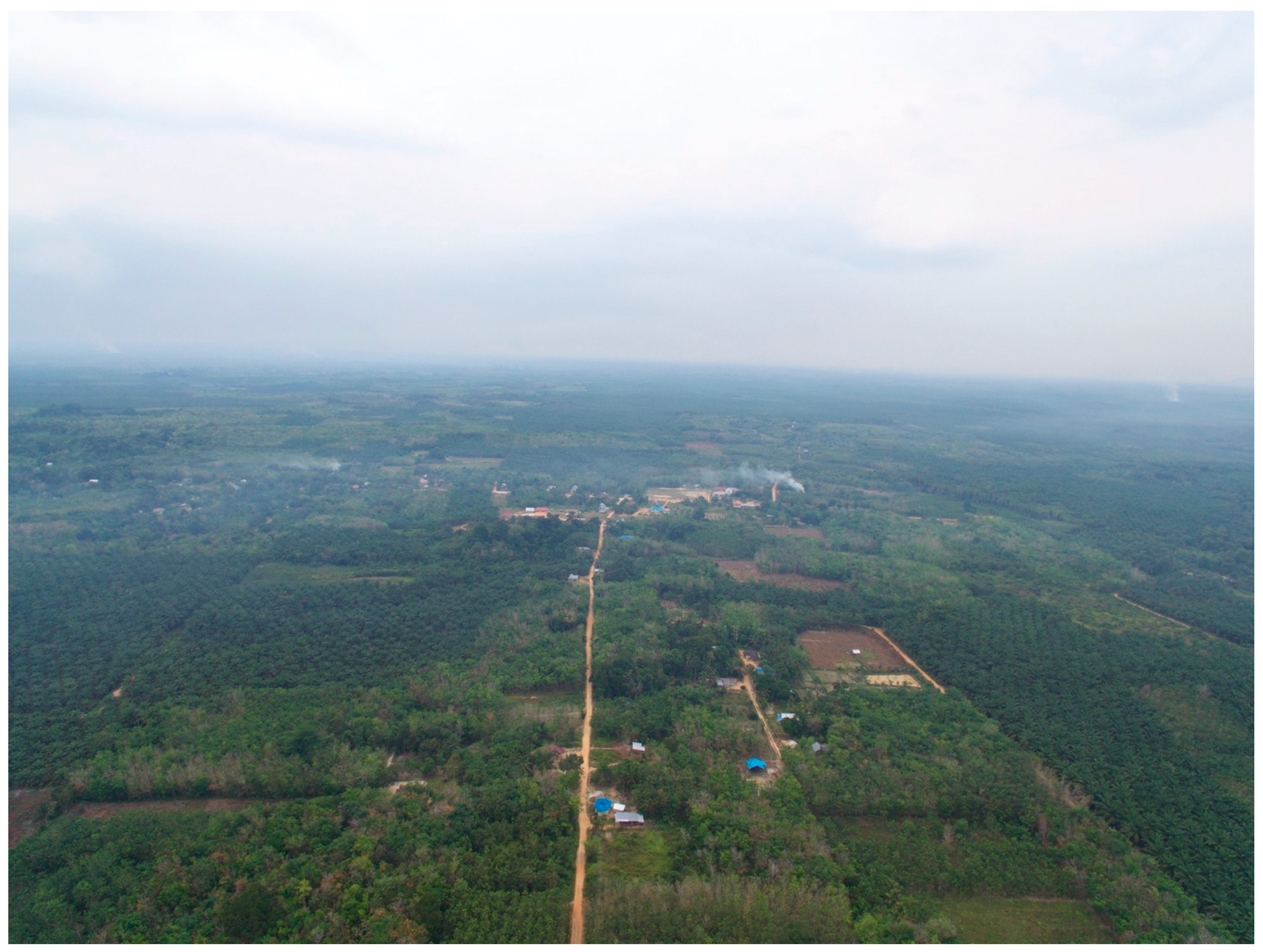
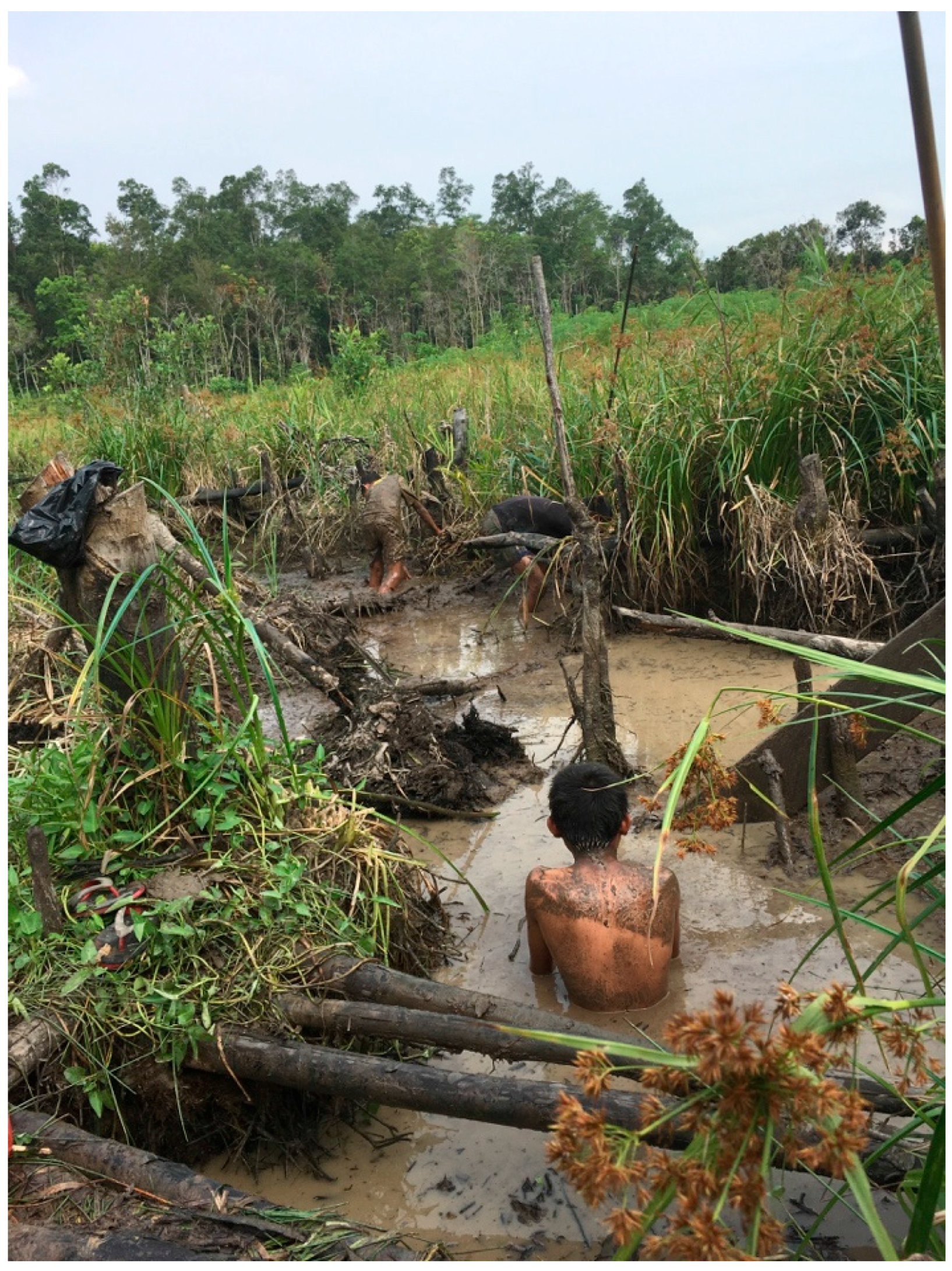
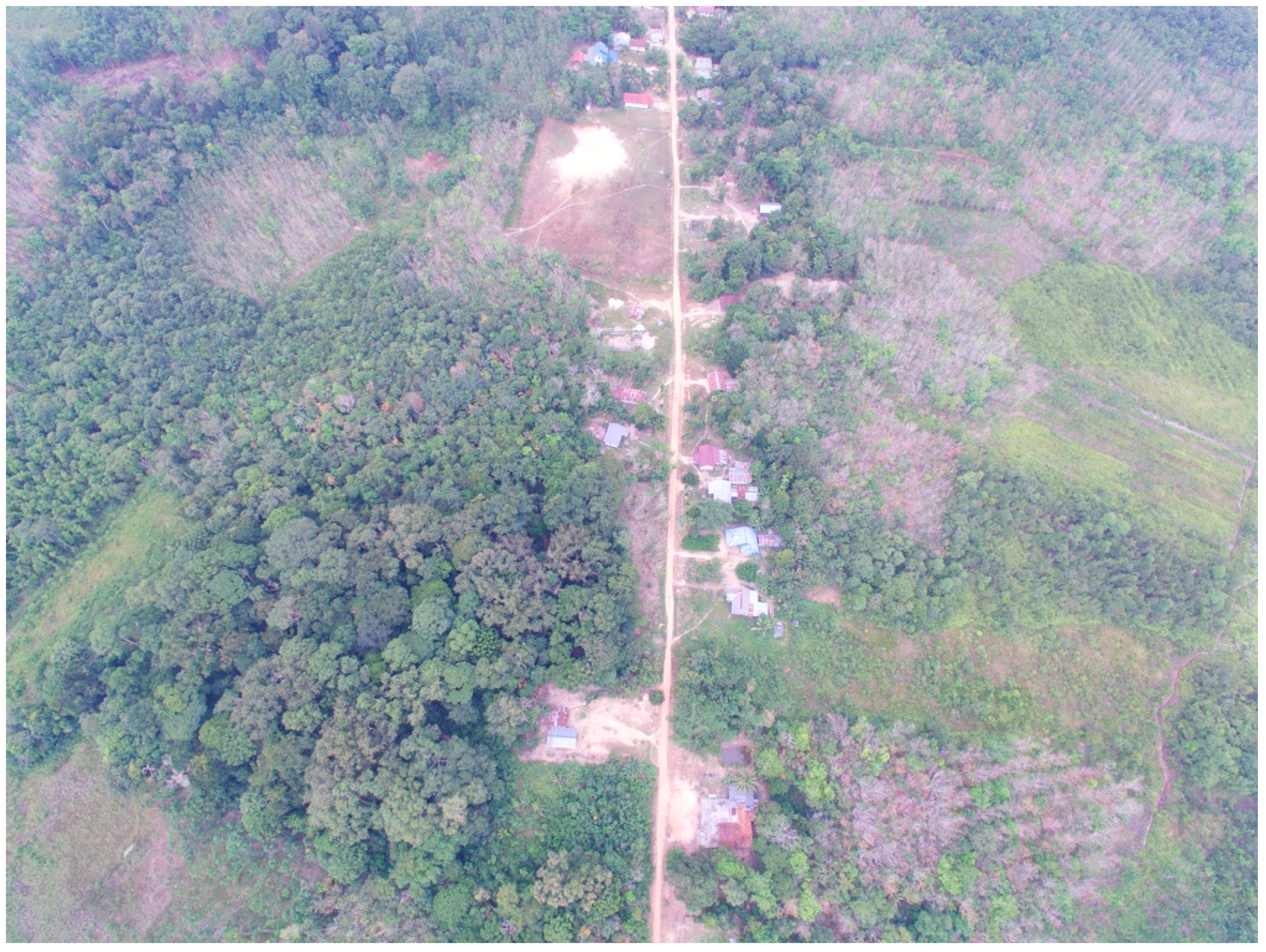
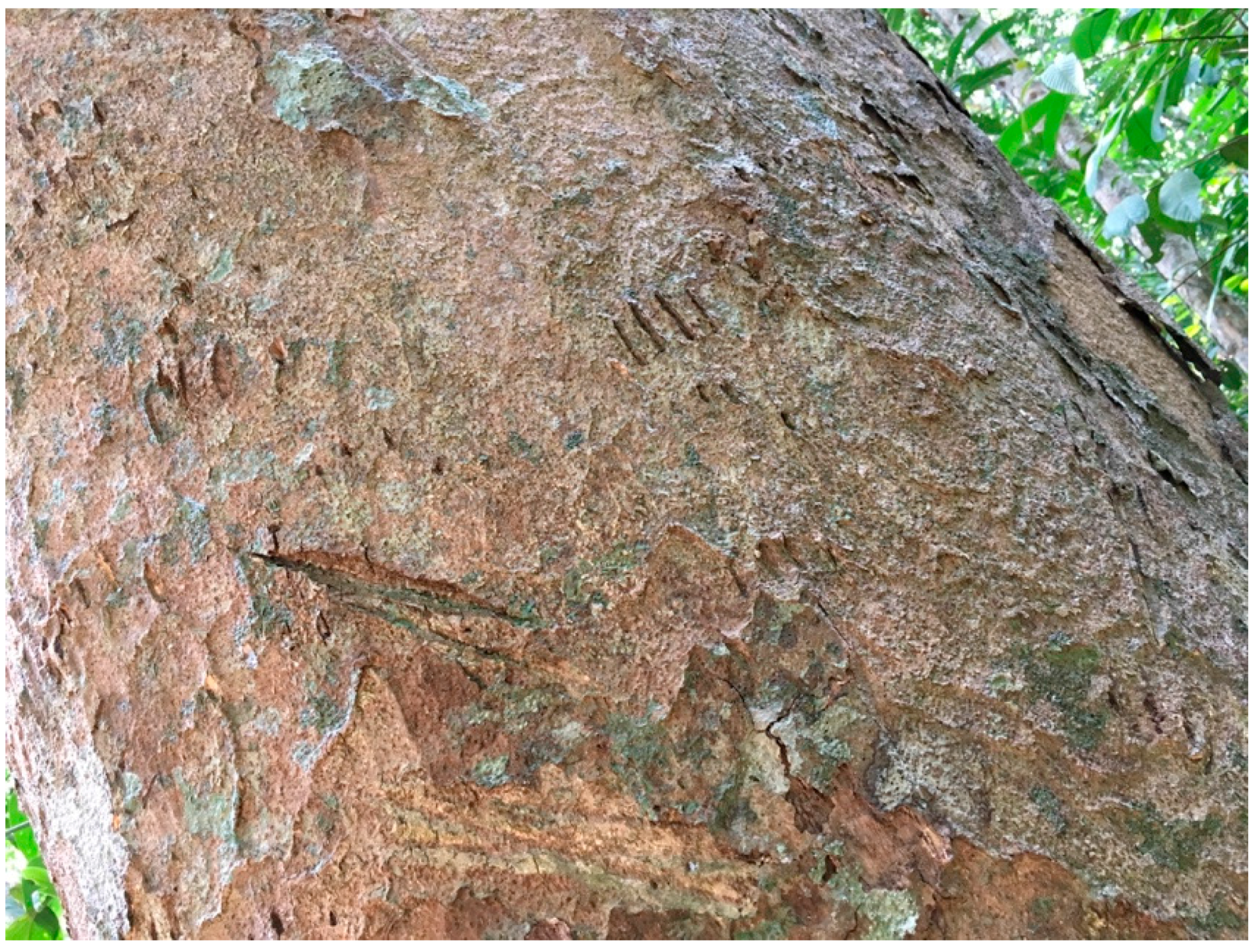
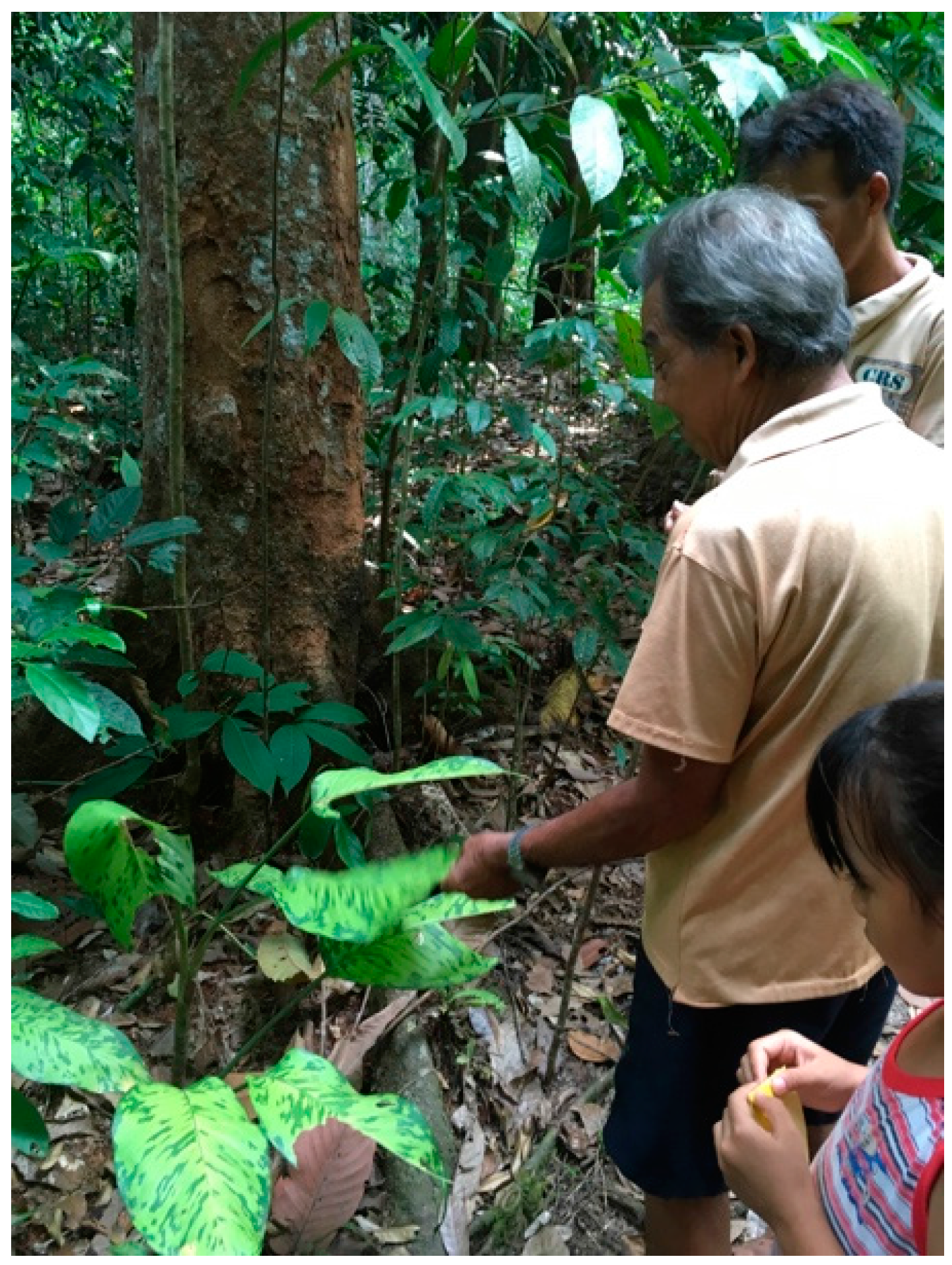
© 2017 by the authors. Licensee MDPI, Basel, Switzerland. This article is an open access article distributed under the terms and conditions of the Creative Commons Attribution (CC BY) license ( http://creativecommons.org/licenses/by/4.0/).
Share and Cite
Langston, J.D.; Riggs, R.A.; Sururi, Y.; Sunderland, T.; Munawir, M. Estate Crops More Attractive than Community Forests in West Kalimantan, Indonesia. Land 2017, 6, 12. https://doi.org/10.3390/land6010012
Langston JD, Riggs RA, Sururi Y, Sunderland T, Munawir M. Estate Crops More Attractive than Community Forests in West Kalimantan, Indonesia. Land. 2017; 6(1):12. https://doi.org/10.3390/land6010012
Chicago/Turabian StyleLangston, James D., Rebecca A. Riggs, Yazid Sururi, Terry Sunderland, and Muhammad Munawir. 2017. "Estate Crops More Attractive than Community Forests in West Kalimantan, Indonesia" Land 6, no. 1: 12. https://doi.org/10.3390/land6010012





